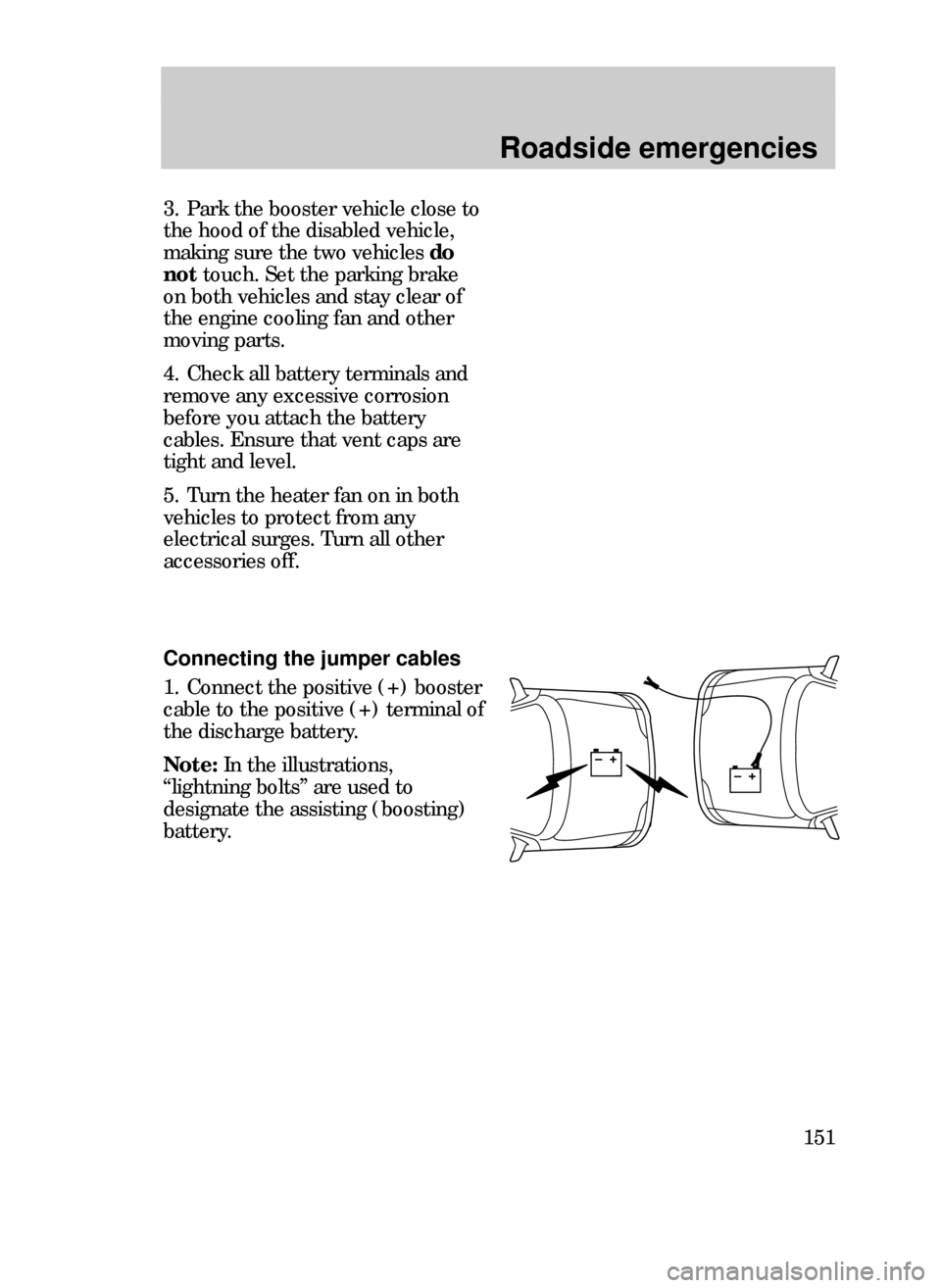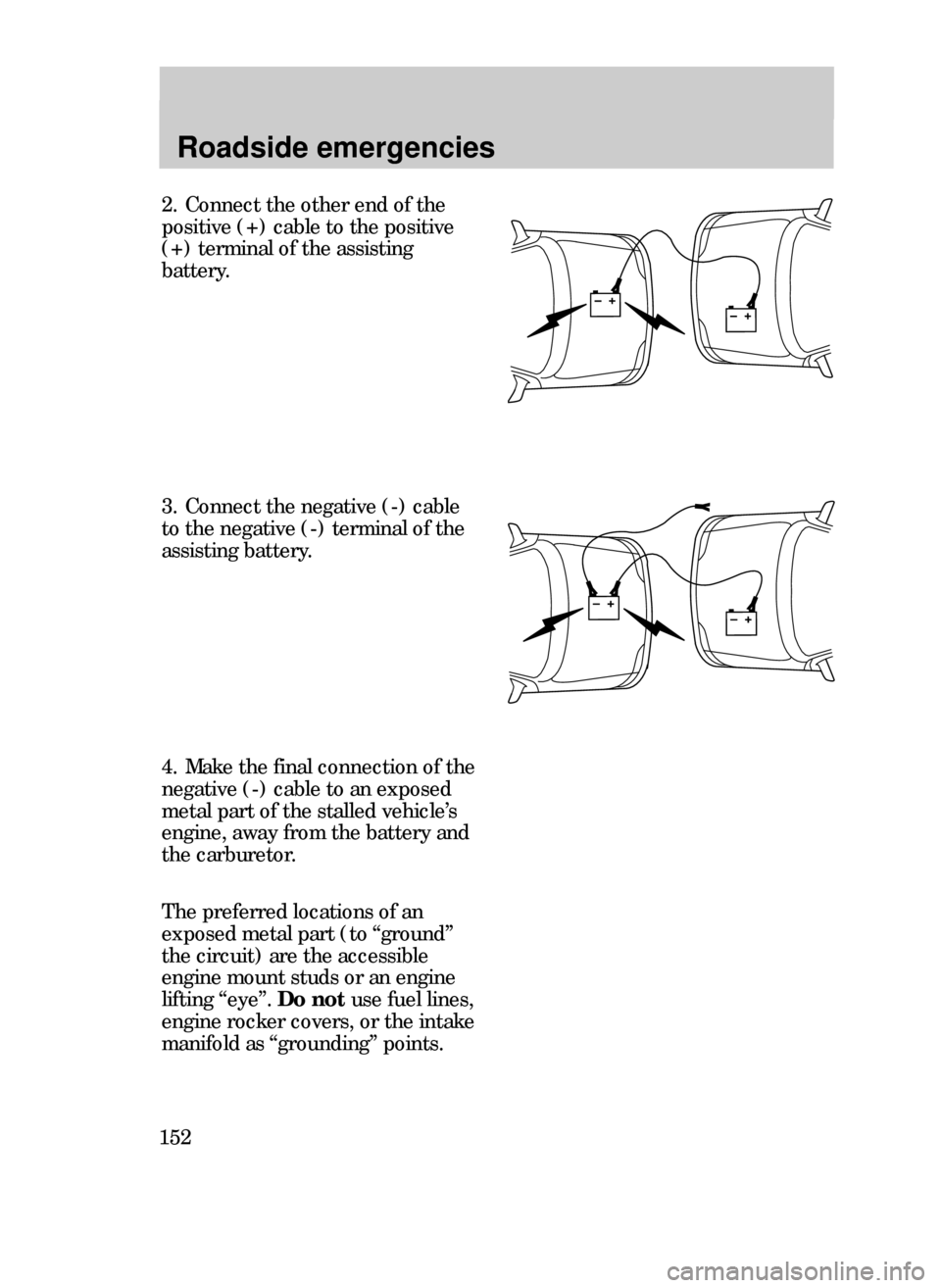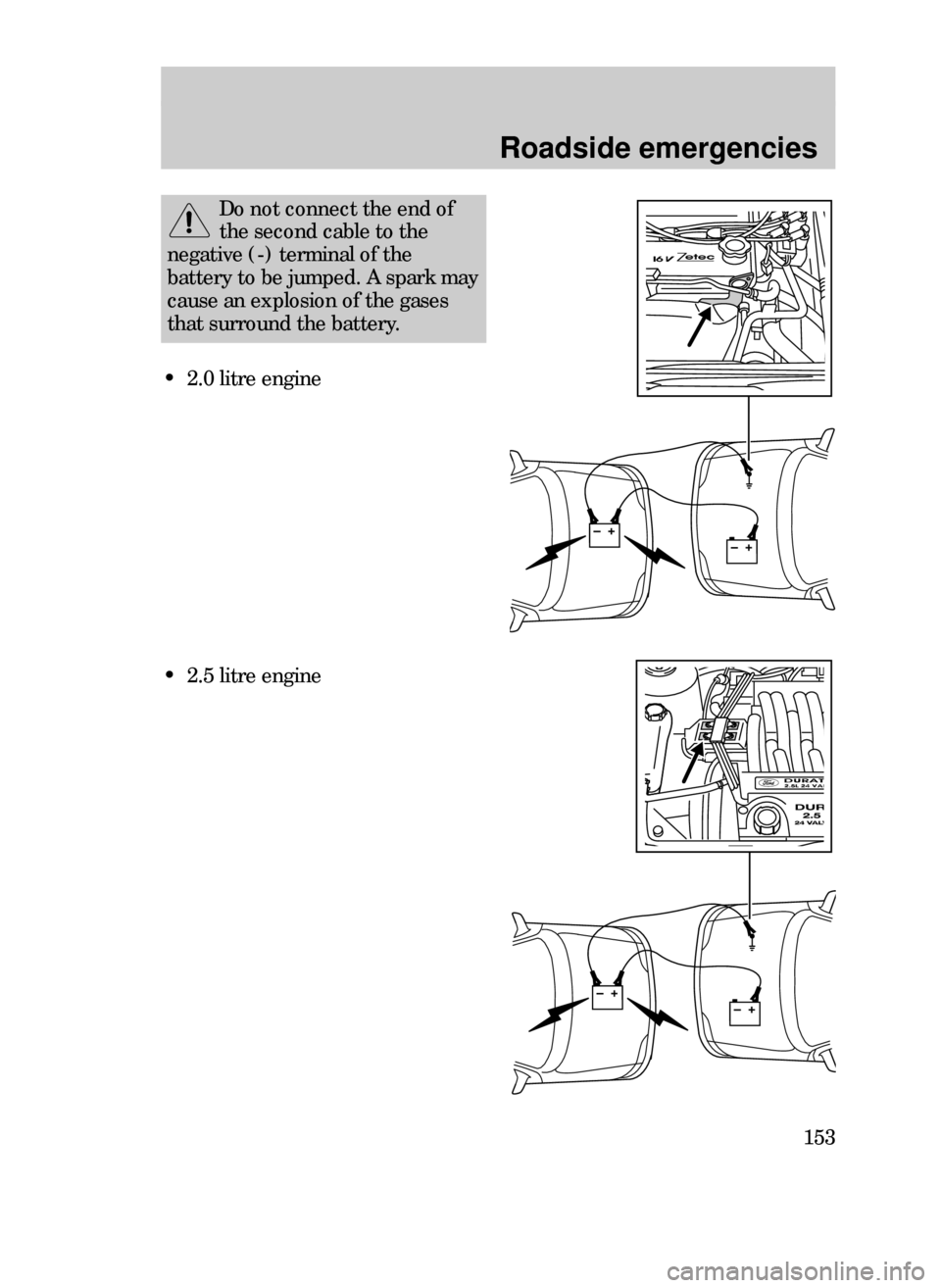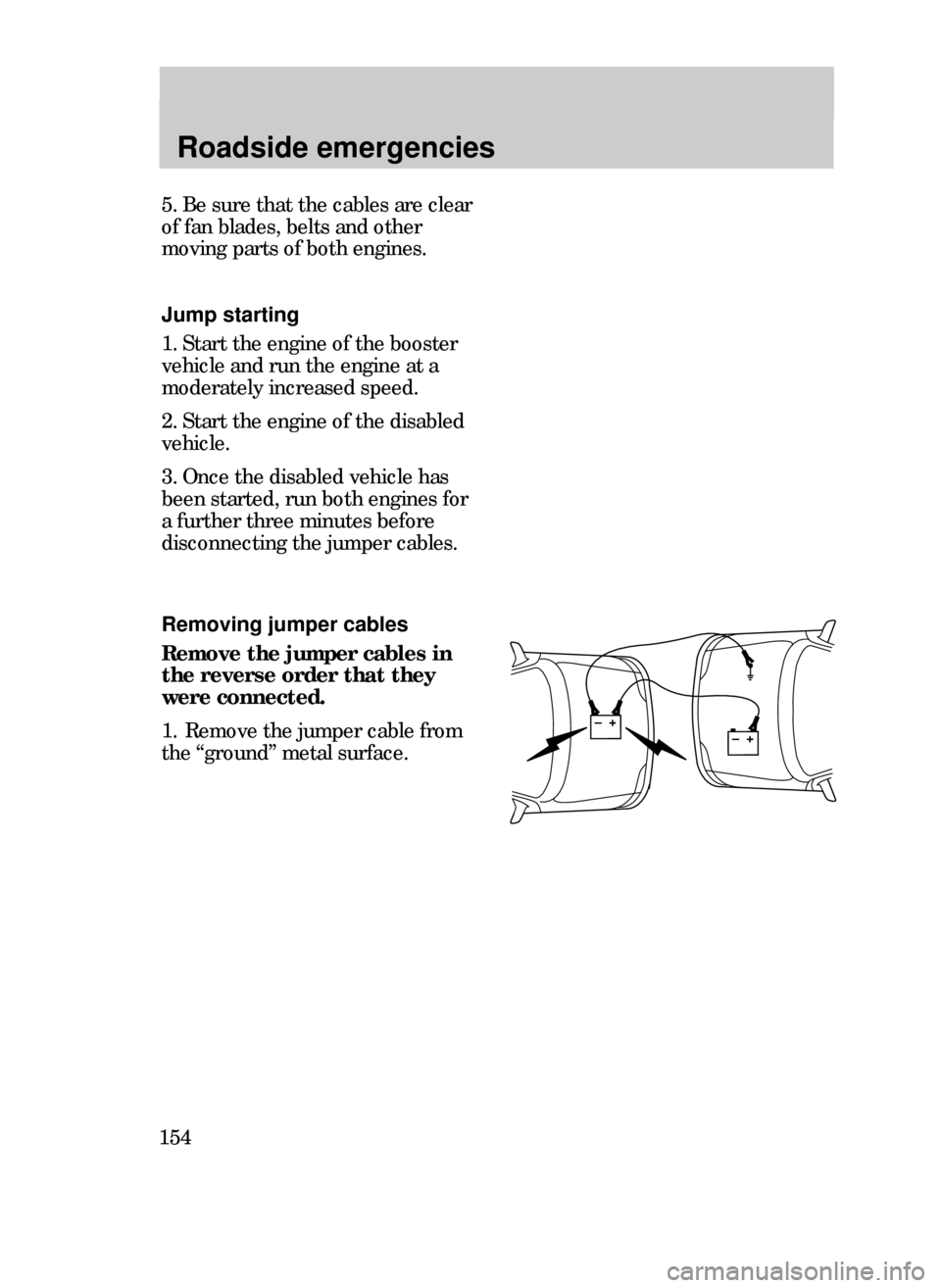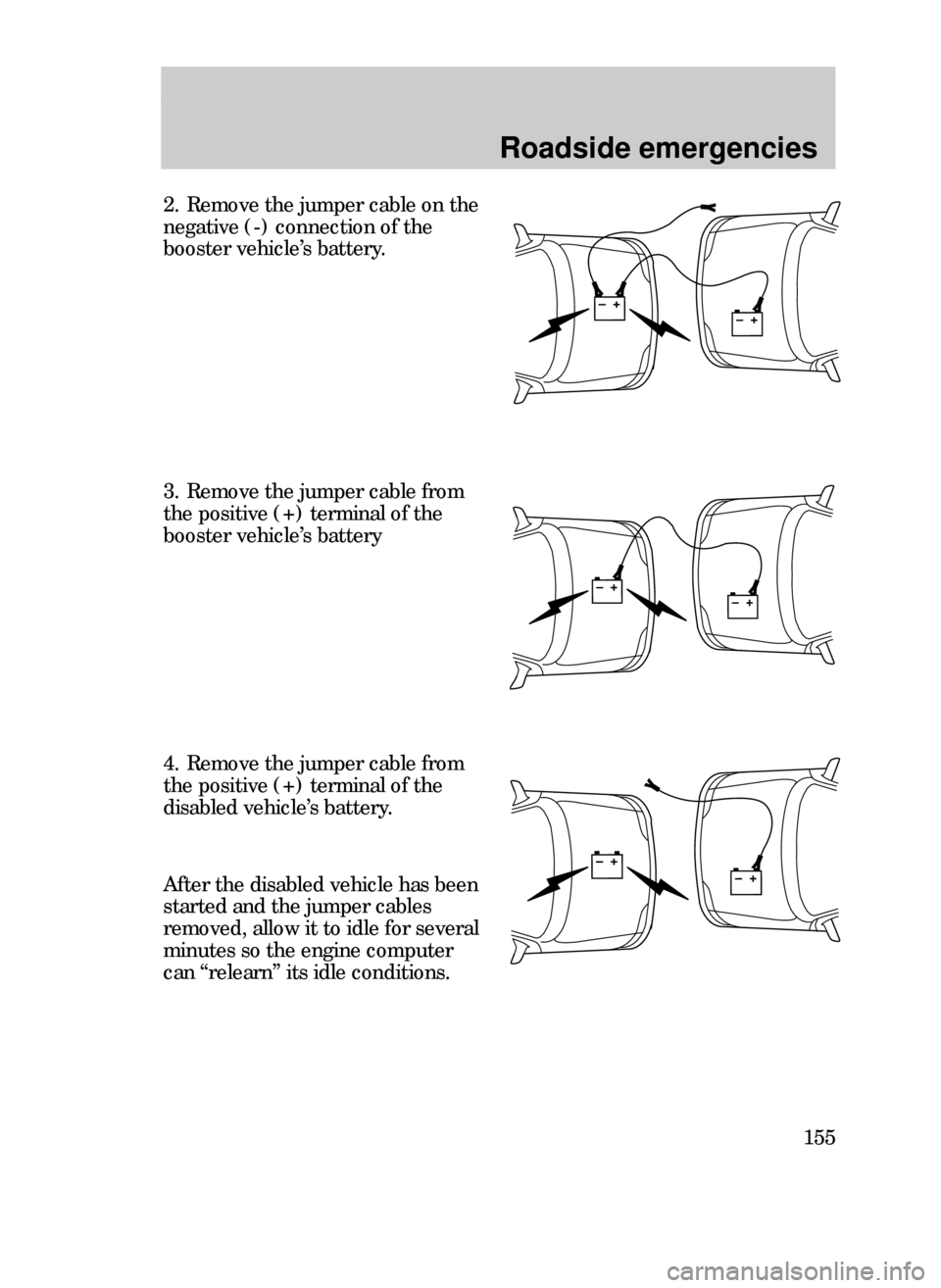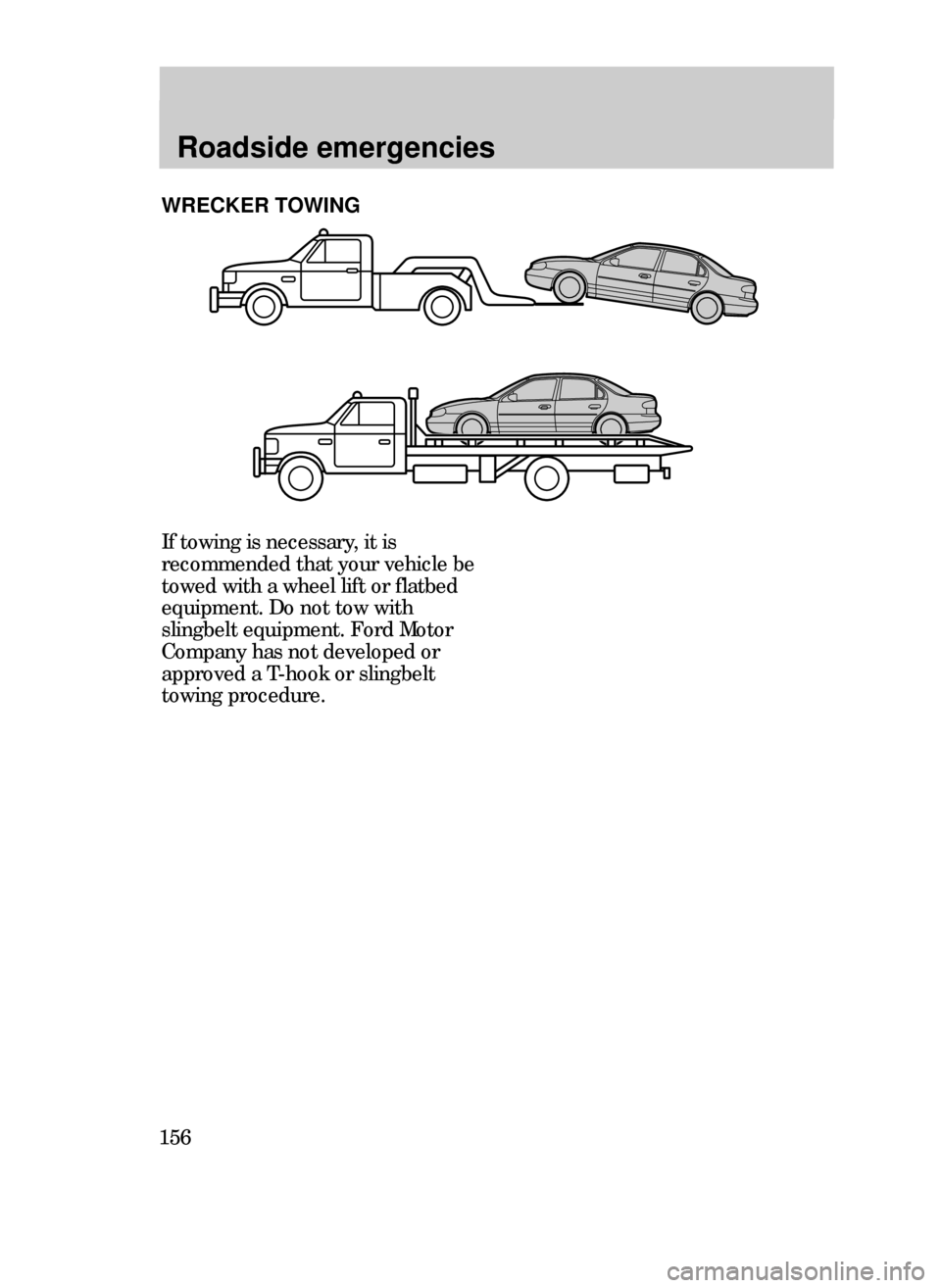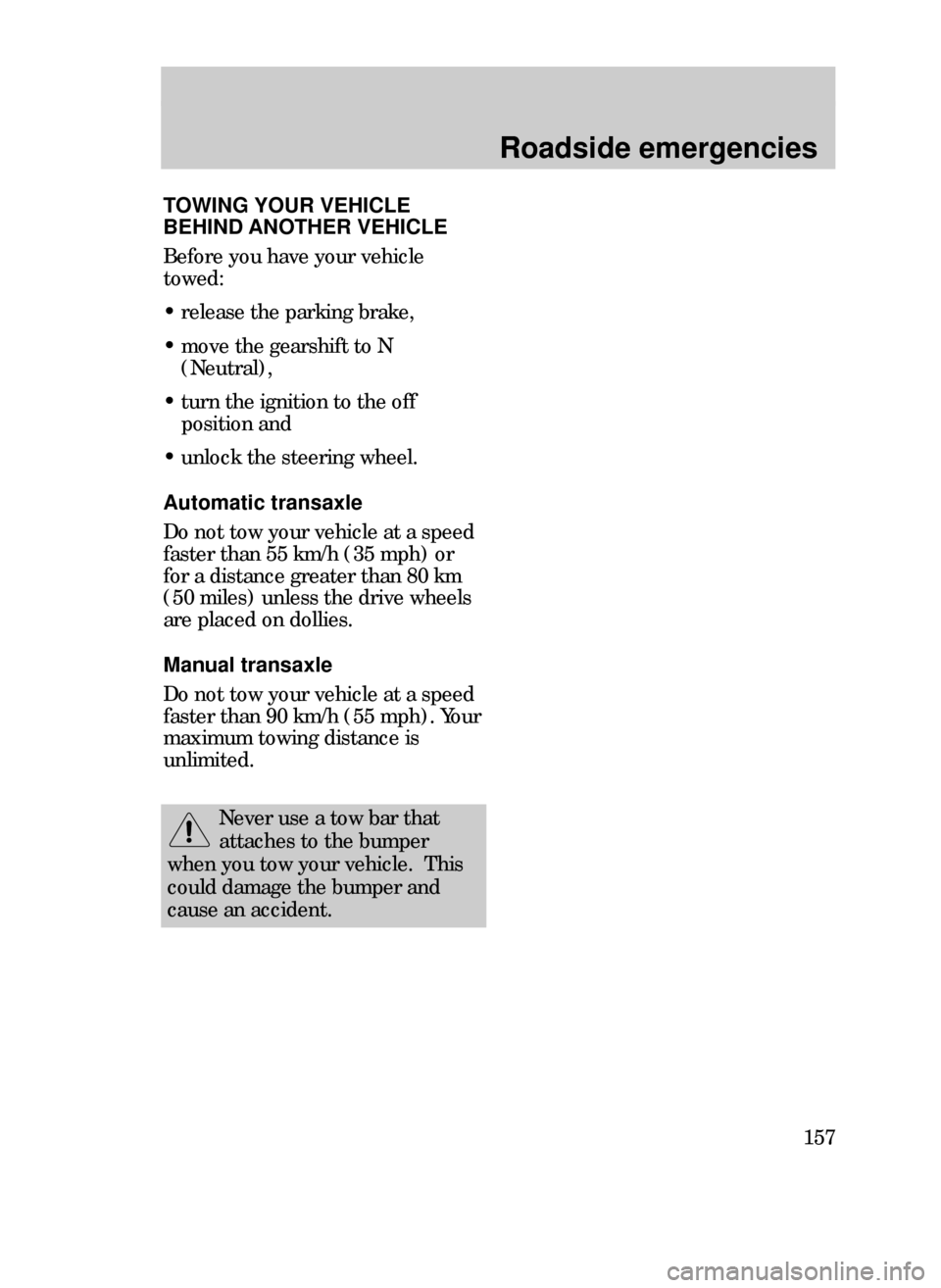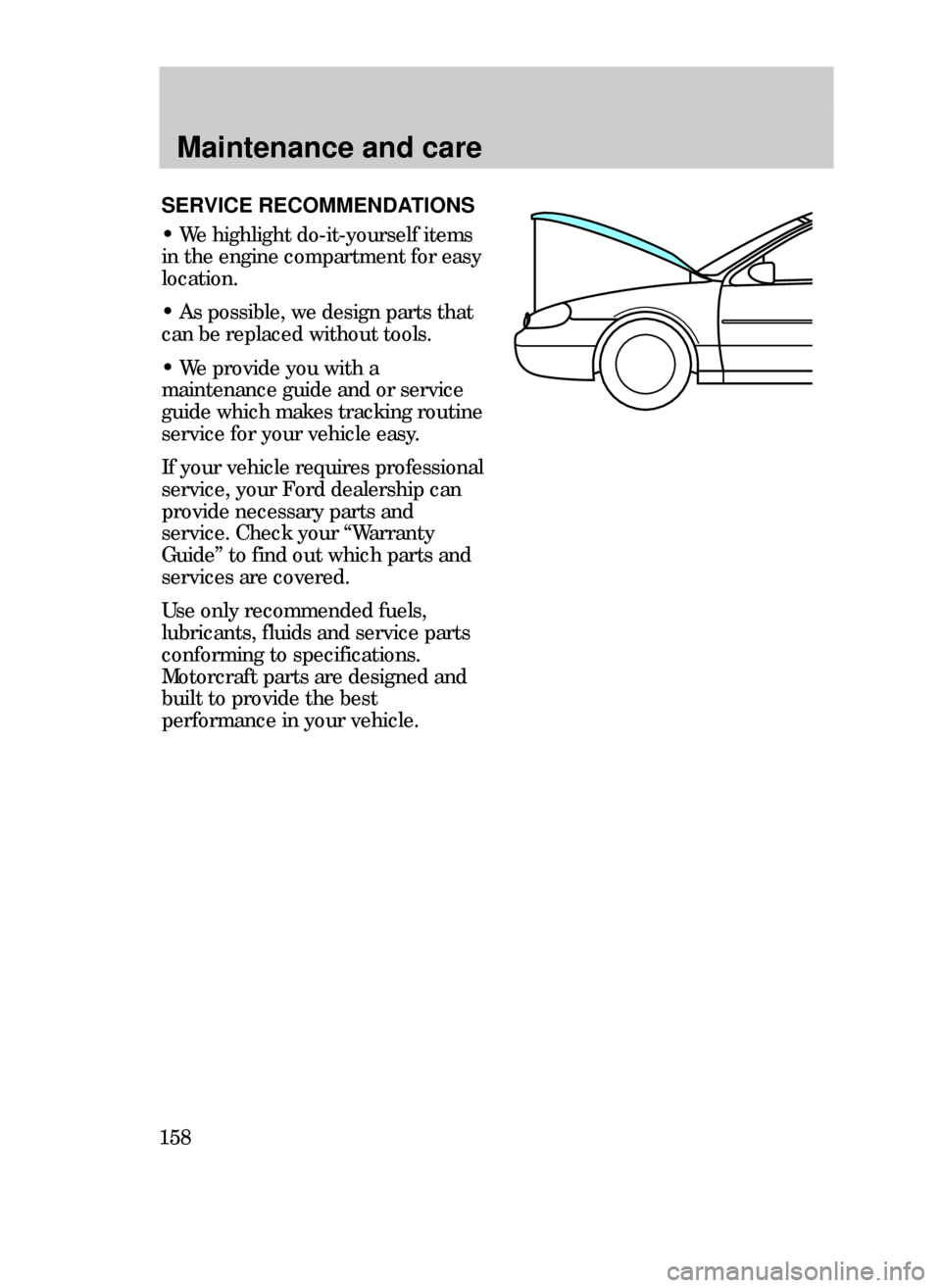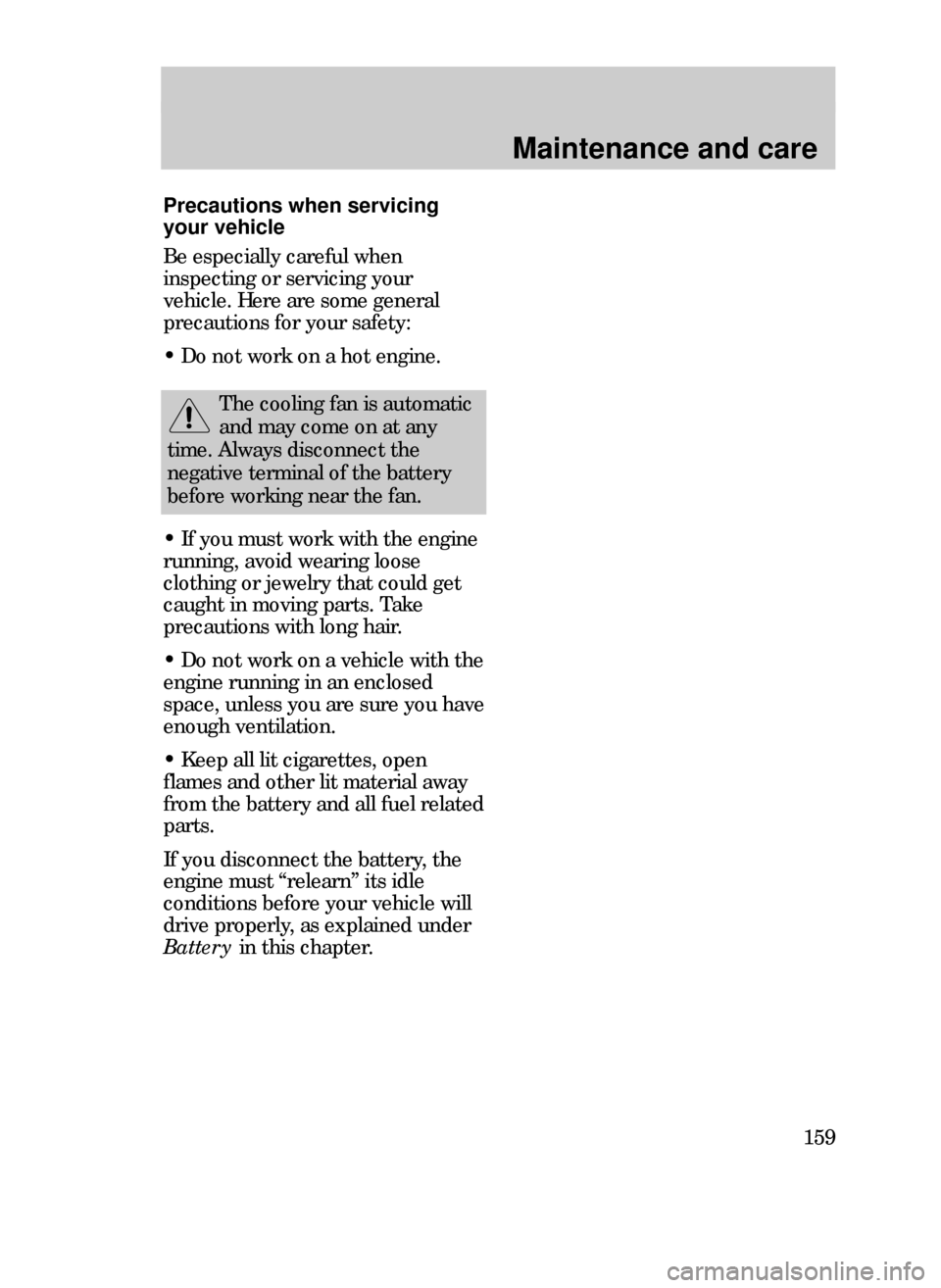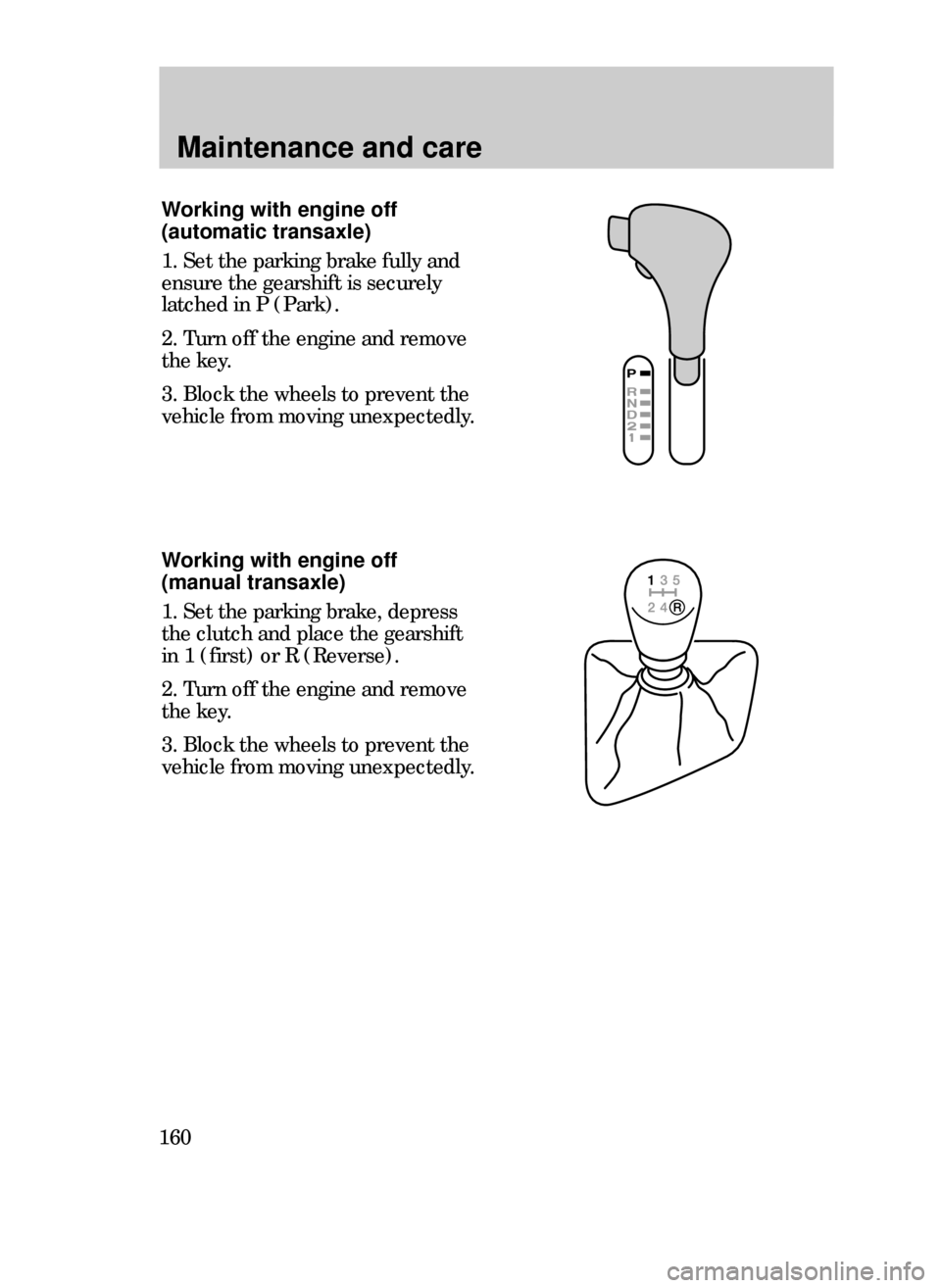FORD CONTOUR 1999 2.G Owners Manual
CONTOUR 1999 2.G
FORD
FORD
https://www.carmanualsonline.info/img/11/4769/w960_4769-0.png
FORD CONTOUR 1999 2.G Owners Manual
Trending: oil, maintenance, height adjustment, oil pressure, spark plugs replace, brakes, fog light
Page 151 of 244
Roadside emergencies
151
3. Park the booster vehicle close to
the hood of the disabled vehicle,
making sure the two vehicles do
nottouch. Set the parking brake
on both vehicles and stay clear of
the engine cooling fan and other
moving parts.
4. Check all battery terminals and
remove any excessive corrosion
before you attach the battery
cables. Ensure that vent caps are
tight and level.
5. Turn the heater fan on in both
vehicles to protect from any
electrical surges. Turn all other
accessories off.
Connecting the jumper cables
1. Connect the positive (+) booster
cable to the positive (+) terminal of
the discharge battery.
Note:In the illustrations,
Òlightning boltsÓ are used to
designate the assisting (boosting)
battery.
23CREen 3/25/99 3:35 PM Page 151
Page 152 of 244
Roadside emergencies
152
2. Connect the other end of the
positive (+) cable to the positive
(+) terminal of the assisting
battery.
3. Connect the negative (-) cable
to the negative (-) terminal of the
assisting battery.
4. Make the final connection of the
negative (-) cable to an exposed
metal part of the stalled vehicleÕs
engine, away from the battery and
the carburetor.
The preferred locations of an
exposed metal part (to ÒgroundÓ
the circuit) are the accessible
engine mount studs or an engine
lifting ÒeyeÓ. Do notuse fuel lines,
engine rocker covers, or the intake
manifold as ÒgroundingÓ points.
23CREen 3/25/99 3:35 PM Page 152
Page 153 of 244
Roadside emergencies
153
Do not connect the end of
the second cable to the
negative (-) terminal of the
battery to be jumped. A spark may
cause an explosion of the gases
that surround the battery.
¥ 2.0 litre engine
¥ 2.5 litre engine
23CREen 3/25/99 3:35 PM Page 153
Page 154 of 244
Roadside emergencies
154
Jump starting
1. Start the engine of the booster
vehicle and run the engine at a
moderately increased speed.
2. Start the engine of the disabled
vehicle.
3. Once the disabled vehicle has
been started, run both engines for
a further three minutes before
disconnecting the jumper cables.
Removing jumper cables
Remove the jumper cables in
the reverse order that they
were connected.
1. Remove the jumper cable from
the ÒgroundÓ metal surface.
5. Be sure that the cables are clear
of fan blades, belts and other
moving parts of both engines.
23CREen 3/25/99 3:35 PM Page 154
Page 155 of 244
Roadside emergencies
155
2. Remove the jumper cable on the
negative (-) connection of the
booster vehicleÕs battery.
4. Remove the jumper cable from
the positive (+) terminal of the
disabled vehicleÕs battery.
3. Remove the jumper cable from
the positive (+) terminal of the
booster vehicleÕs battery
After the disabled vehicle has been
started and the jumper cables
removed, allow it to idle for several
minutes so the engine computer
can ÒrelearnÓ its idle conditions.
23CREen 3/25/99 3:35 PM Page 155
Page 156 of 244
Roadside emergencies
156
If towing is necessary, it is
recommended that your vehicle be
towed with a wheel lift or flatbed
equipment. Do not tow with
slingbelt equipment. Ford Motor
Company has not developed or
approved a T-hook or slingbelt
towing procedure.
WRECKER TOWING
23CREen 3/25/99 3:35 PM Page 156
Page 157 of 244
Roadside emergencies
157
Never use a tow bar that
attaches to the bumper
when you tow your vehicle. This
could damage the bumper and
cause an accident.
TOWING YOUR VEHICLE
BEHIND ANOTHER VEHICLE
Before you have your vehicle
towed:
¥ release the parking brake,
¥ move the gearshift to N
(Neutral),
¥ turn the ignition to the off
position and
¥ unlock the steering wheel.
Automatic transaxle
Do not tow your vehicle at a speed
faster than 55 km/h (35 mph) or
for a distance greater than 80 km
(50 miles) unless the drive wheels
are placed on dollies.
Manual transaxle
Do not tow your vehicle at a speed
faster than 90 km/h (55 mph). Your
maximum towing distance is
unlimited.
23CREen 3/25/99 3:35 PM Page 157
Page 158 of 244
Maintenance and care
158
SERVICE RECOMMENDATIONS
¥ We highlight do-it-yourself items
in the engine compartment for easy
location.
¥ As possible, we design parts that
can be replaced without tools.
¥ We provide you with a
maintenance guide and or service
guide which makes tracking routine
service for your vehicle easy.
If your vehicle requires professional
service, your Ford dealership can
provide necessary parts and
service. Check your ÒWarranty
GuideÓ to find out which parts and
services are covered.
Use only recommended fuels,
lubricants, fluids and service parts
conforming to specifications.
Motorcraft parts are designed and
built to provide the best
performance in your vehicle.
31CMCen 3/25/99 3:45 PM Page 158
Page 159 of 244
Maintenance and care
159
Precautions when servicing
your vehicle
Be especially careful when
inspecting or servicing your
vehicle. Here are some general
precautions for your safety:
¥ Do not work on a hot engine.
The cooling fan is automatic
and may come on at any
time. Always disconnect the
negative terminal of the battery
before working near the fan.
¥ If you must work with the engine
running, avoid wearing loose
clothing or jewelry that could get
caught in moving parts. Take
precautions with long hair.
¥ Do not work on a vehicle with the
engine running in an enclosed
space, unless you are sure you have
enough ventilation.
¥ Keep all lit cigarettes, open
flames and other lit material away
from the battery and all fuel related
parts.
If you disconnect the battery, the
engine must ÒrelearnÓ its idle
conditions before your vehicle will
drive properly, as explained under
Battery in this chapter.
31CMCen 3/25/99 3:45 PM Page 159
Page 160 of 244
Maintenance and care
160
Working with engine off
(automatic transaxle)
1. Set the parking brake fully and
ensure the gearshift is securely
latched in P (Park).
2. Turn off the engine and remove
the key.
3. Block the wheels to prevent the
vehicle from moving unexpectedly.
Working with engine off
(manual transaxle)
1. Set the parking brake, depress
the clutch and place the gearshift
in 1 (first) or R (Reverse).
2. Turn off the engine and remove
the key.
3. Block the wheels to prevent the
vehicle from moving unexpectedly.
31CMCen 3/25/99 3:45 PM Page 160
Trending: fold seats, heating, low beam, door lock, engine coolant, OBD port, transmission oil
